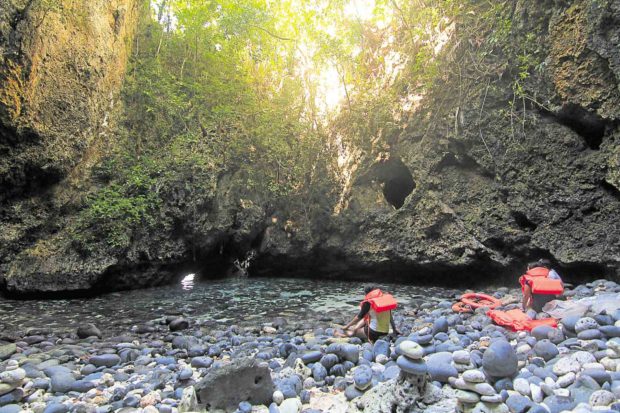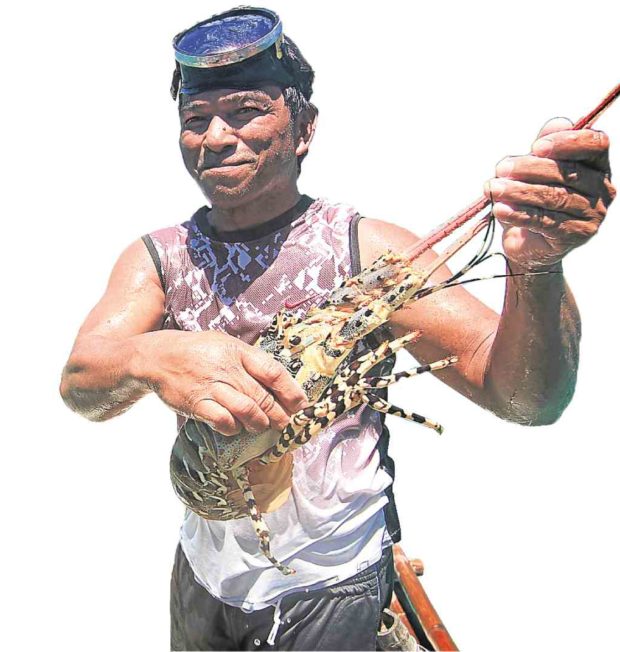Beach stays ‘in pink of health’

The pink beach of Subic is among the top attractions of Matnog town in Sorsogon province. —Photos by Mark Alvic Esplana
MATNOG, SORSOGON—Considered mainland Luzon’s gateway to the Visayas region, this town in Sorsogon province is striving to keep its top tourist attraction in the pink of health amid rising visitor arrivals in the past several years.
Subic beach in Barangay Calintaan is known for its pinkish sand and rich marine biodiversity, and it has remained pristine despite the influx of tourists as a result of community and local government initiatives. It can be reached in 30 minutes by boat from the Matnog port.
For instance, visitors must undergo a 5-minute briefing on proper waste disposal and the importance of keeping the beach clean before they are brought to the island by outrigger boats. Once onboard, they are told to use plastic bags that every boat operator is required to bring along so they can segregate their trash.
“We inculcate in their minds the negative effects of garbage to the environment if these are not disposed of properly,” said Miguel Hular, municipal tourism officer.

Tourists interact with different species of fish at Juag lagoon.
Secret to cleanliness
Article continues after this advertisementThe strict implementation of proper garbage disposal is the secret to keeping the beach clean, Hular said.
Article continues after this advertisementA group of 25 women keeps the beach clean, said Nonie Enolva, spokesperson of the regional Bureau of Fisheries and Aquatic Resources.
The women were organized by the Department of Agriculture under the Philippine Rural Development Project and the US Agency for International Development program’s Ecosystems Improved for Sustainable Fisheries (Ecofish) Project.
Wastes, particularly plastic food containers and wrappers, collected from the beach are hauled every two weeks to the town center for segregation and disposal, Hular said. Some biodegradable wastes are buried somewhere on the island and away from shore.
According to Enolva, Subic’s sand is pink because red fragments of organ pipe coral (Tubipora musica) have mixed with white sand in the area.
Ruby Silva, 62, a court employee, keeps coming back to Subic’s serene environment. “I love how the sea looks—it’s very calm and relaxing. And the most important thing is [the trip] is affordable,” she said.
Island stay
Small hotels and inns offer overnight stay on Subic Island, while cottages with anahaw roofs and nipa huts are available for day visitors. Potable water and electricity supplies are available.
Backpackers from Europe, China, Korea and the United States have visited Subic, Hular said.
The local government has assured the safety of visitors. Nonuniformed policemen and soldiers secure the area, while Philippine Coast Guard personnel regularly conduct sea patrols.
Boat rental to islands of Subic and Tikling, another destination featuring a pink sand beach, ranges from P1,800 to P2,500, if accompanied by a diver (locally called a water guide).
Diving and snorkeling enthusiasts will enjoy exploring the reefs teeming with marine life off Matnog.
The private Juag lagoon marine sanctuary, a 5-minute boat ride away from Subic beach, is also a popular site for tourists who want a unique experience of swimming with different
fish and marine animals. The 5,762-square-meter lagoon is home to 40 fish species.
About 50 boats visit daily, ferrying 500 tourists, said Alex Geneblazo, 48, who owns the sanctuary.
“I’m happy that our sleepy place has become a blockbuster. The truth is this all started as a hobby. I did not expect that many people would come. I feel great (that) I make people happy and the sanctuary has contributed to growth of tourism in the province,” he said.
Geneblazo started the “sea aquarium” in 2000 with a few pairs of milkfish fed with seaweed. The community thrived with other live fish he bought from fishermen.
Now, the place features lapu-lapu (grouper), yellowfin tuna, lobsters, giant clams and sea cucumbers, among others.

Visitors explore a seaside cave in the village of Calintaan.
Cave exploration
Tourists are allowed to swim with the fish as long as they do not apply lotion, cream or other skin products that might be toxic to marine life. They can feed the sea creatures from a plate worth P100.
Visitors are also encouraged to donate any amount to maintain the area.
To protect the species from threats during calamities, Geneblazo makes sure that the posts are strong and the nets are tall around the sanctuary.
Another 10-minute boat ride will take tourists to explore the caves near Subic beach.
Sha Morata, 45, a local guide, said tourists should savor the experience of squeezing through the tight cave entrances before they are rewarded with a view of a small beach with shallow waters perfect for a leisurely swim.

Alex Geneblazo’s marine sanctuary helps promote Matnog tourism.
River cruise
Those returning to the capital city of Sorsogon in the afternoon can take the Buhatan River Cruise and Eco Adventure in the village of Buhatan.
A floating cabana supported by bamboo rafts takes tourists to a 40-minute cruise through mangrove forests and endemic trees stretching for 3.9 kilometers. A local artist plays kundiman songs for tourists on the cruise.
As the cabana returns to port early evening, tourists are treated to a sight of fireflies flickering in the mangroves, a star-filled sky and a chorus of chirping birds and crickets.
The vessel can be rented for P2,000 and accommodate at most 10 people. Food may be served for an additional fee of P1,700.
Many villagers earn by selling their products, such as cacao sweets and polvoron made of pili nuts, to tourists, said Mina Fulo, a tourist guide.
The cruise was a product of a river cleanup project initiated by the city government then headed by Mayor Sally Lee and Sorsogon Gov. Robert Lee Rodrigueza in 2016.